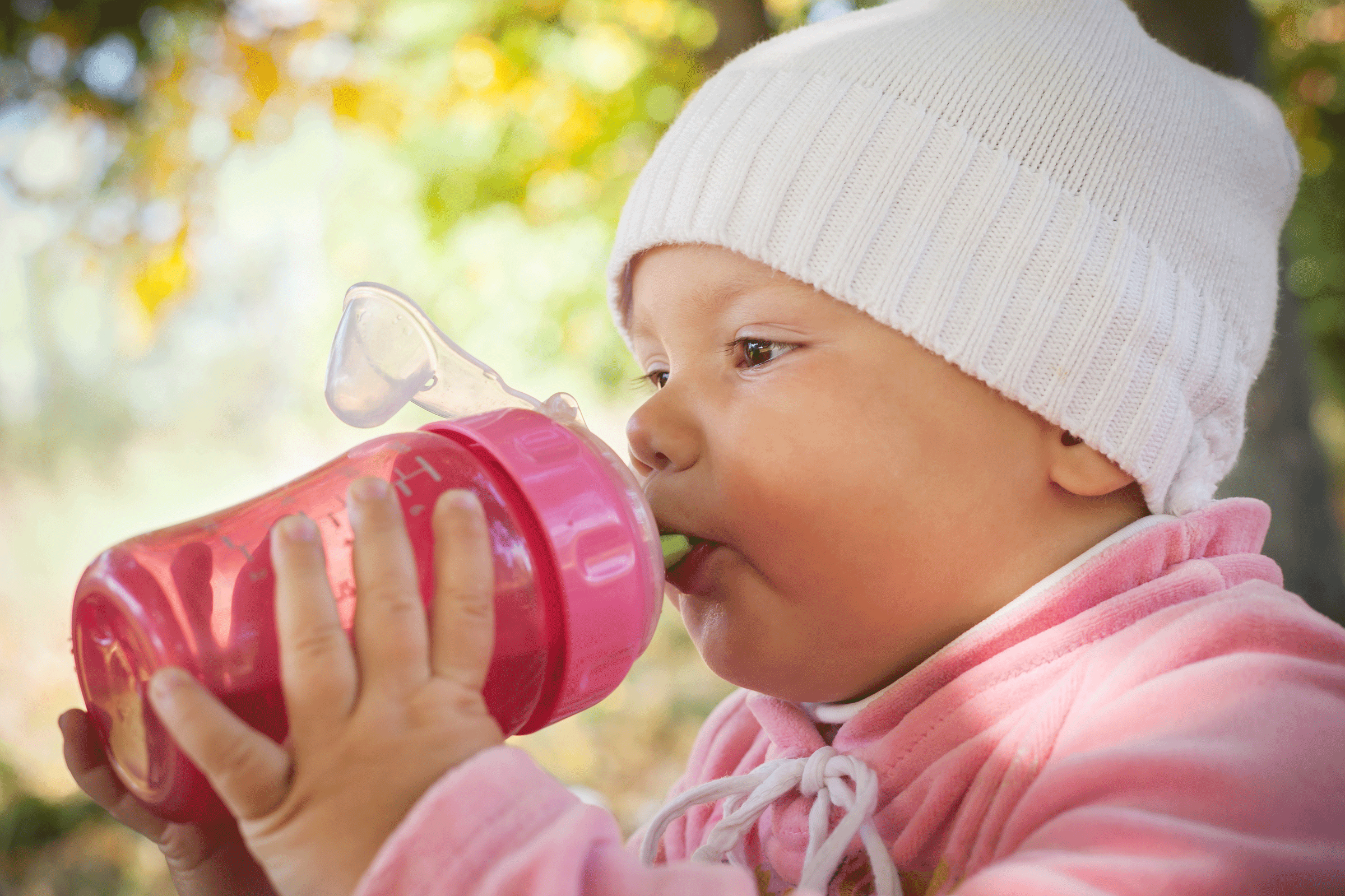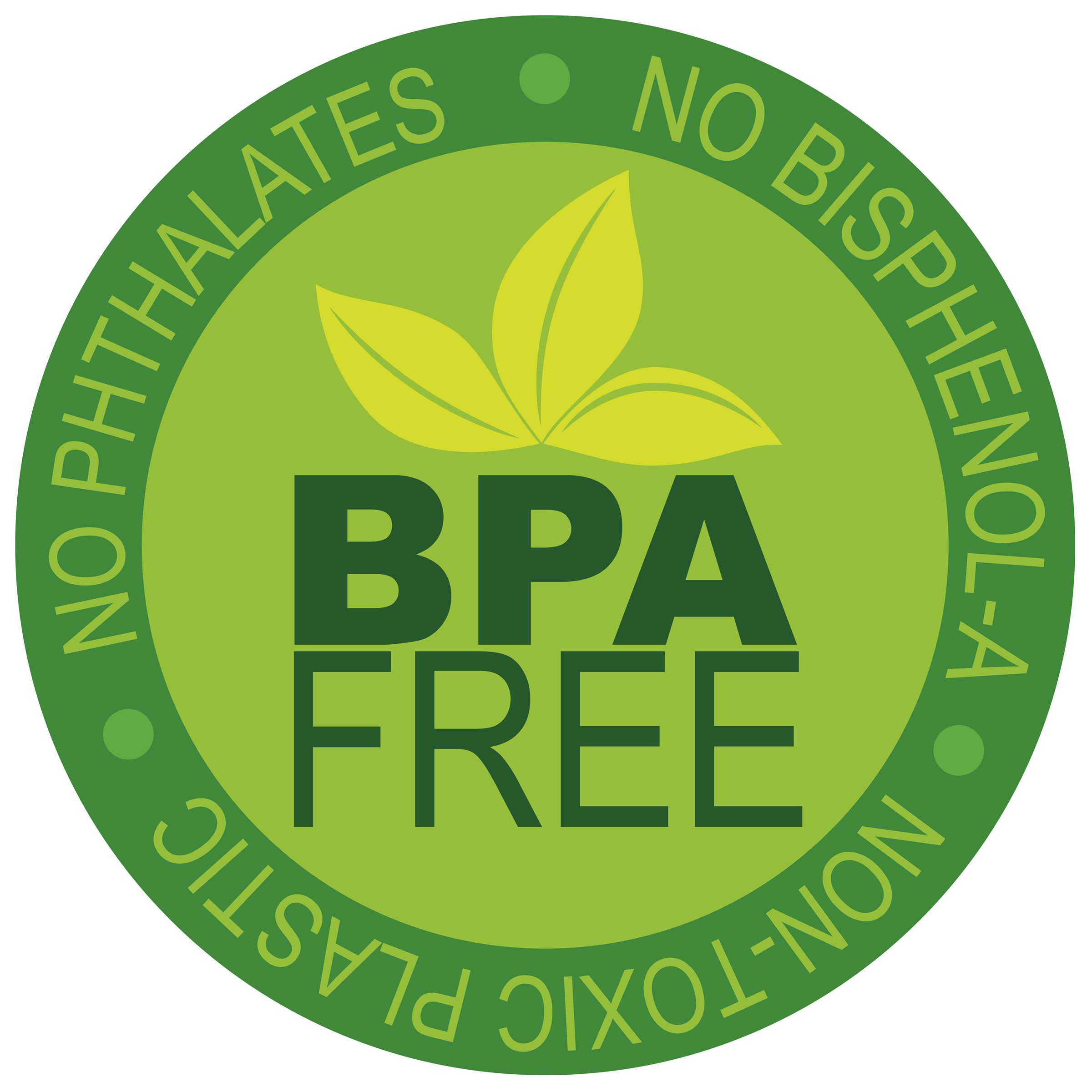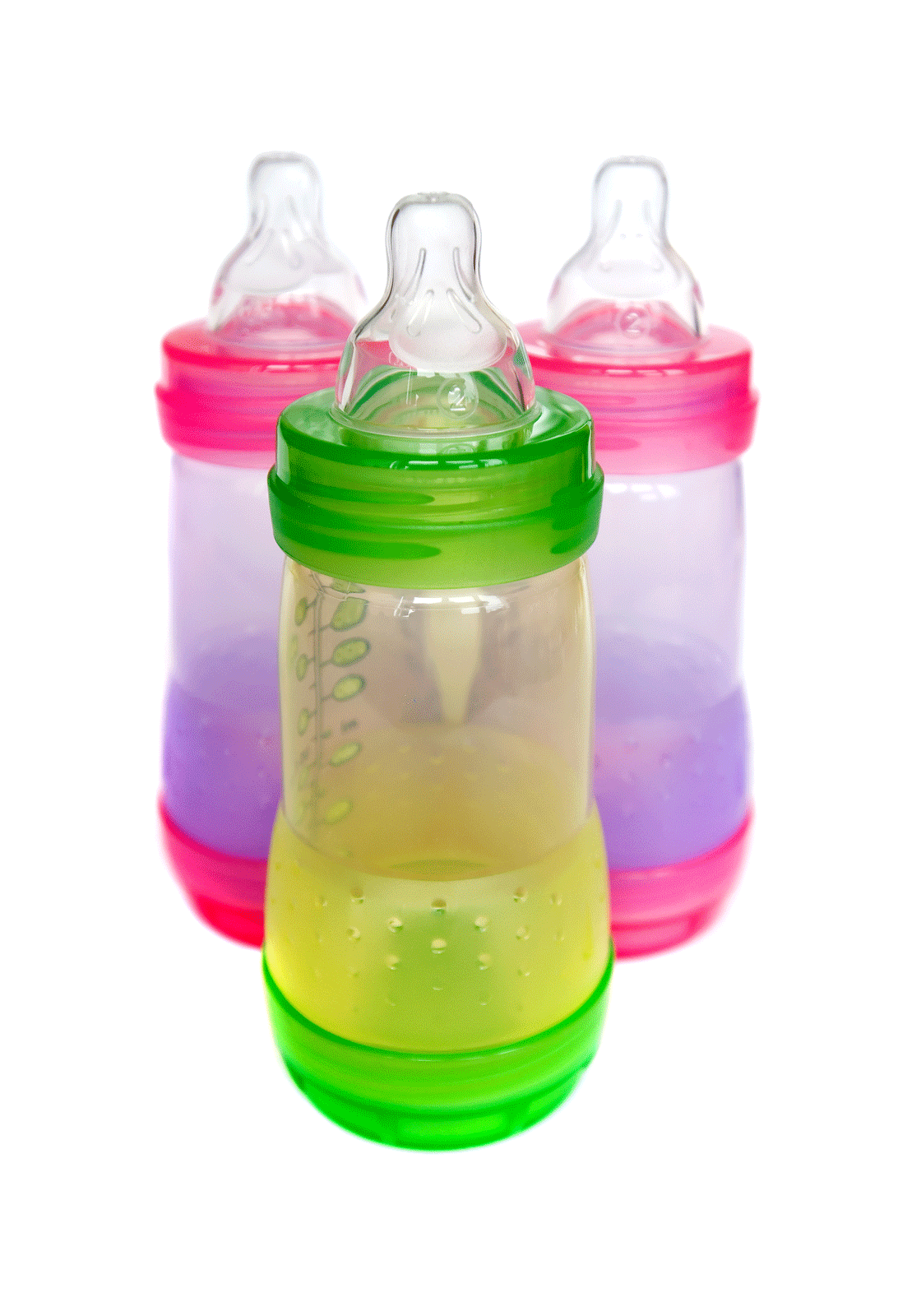BPA-Free Does Not Always Mean Safe
Air Date: Week of March 14, 2014

BPA has been banned from children’s products like sippy cups and bottles but some plastics used to replace BPA were also found to contain dangerous estrogenic chemicals. (bigstockphoto.com)
Consumer worries and health concerns helped prompt the FDA to ban Bisphenol A (BPA) in children’s products. But an investigative report in Mother Jones finds replacement plastics may be just as hazardous. Report author Mariah Blake explains the evidence to host Steve Curwood.
Transcript
CURWOOD: Along with the environmental costs of manufacturing plastics, there is another set of risks. Though those numbers on the bottom tell you what can be recycled, plastic waste now litters the earth and seas, and what once seemed an inert material can sometimes affect human health. The widely used ingredient bisphenol A, BPA, has been shown to affect the hormone system by mimicking estrogen.
Now it's widely banned in baby bottles and children's sippy cups. Firms have created BPA-free alternatives - products like Tritan - but recent research suggests that the replacements and many other plastics are no safer. Mariah Blake, a reporter with Mother Jones, has investigated just what's in those plastics. She says there was certainly reason to get rid of Bisphenol-A.
BLAKE: The health hazards of BPA are well documented and they are numerous. So they range from breast and prostate cancer to diabetes to heart disease to increased aggression and Attention Deficit Disorder. The list is pretty long and surprisingly diverse. There is no longer any legitimate scientific debate about the health effects of BPA.
CURWOOD: Now, the chemical industry got rid of BPA from some products, but it’s still fairly widely used, I understand.
BLAKE: Yes, so BPA is still ubiquitous in plastics. There is a kind of plastic called polycarbonate that contains BPA, and it’s still used for many things. BPA is also present in the lining of tin cans, and in cash register receipts. So if you receive a cash register receipt and it has a sort of slippery quality, that’s because it has a BPA coating on it.
CURWOOD: So there were plastics that were put together to replace BPA so that other things could be used for baby bottles and sippy cups and water containers, so what kind of testing has been done on these other plastics?
BLAKE: The way it works in the United States, most chemicals have never been tested for safety, so there’s more than 80,000 chemicals that are used in commerce in the United States, and only a very tiny fraction of those have been tested for safety. And chemicals are generally presumed safe until proven otherwise. So these plastics that are being used to replace polycarbonate - the BPA laden plastic - we don’t necessarily know much about their safety.
CURWOOD: Now you document the research and testing done by, well, shall I call them a colorful cast of characters?
BLAKE: I think that’s a fair characterization, yes.
CURWOOD: Now, they’re trying to solve the mystery of the effects of these plastics. One of the colorful people in this is a gentleman named Bittner. Tell me a little bit about him.

BPA free does not necessarily mean that a plastic product is also free of any estrogenic chemicals. (bigstockphoto.com)
BLAKE: George Bittner is a University of Texas professor who launched a private company called CertiChem, and CertiChem tests products for estrogenic activity. It’s hard to know which ones do and do not have these chemicals in them. You cannot tell by the numbers stamped on the bottom of them, so traditionally people have believed that, plastics, for example, that have the number one stamped on the bottom of them - that’s PET or PETE - were safe. Now, in Bittner’s tests, 75 percent of these tested positive for estrogenic activity. That doesn’t mean that all of them have estrogenic activity, but we can’t tell without actually testing them which ones do and which ones don’t. So it really creates a quandary for consumers.
CURWOOD: Now, what has been the response of the manufacturers of plastic products to these tests being done by independent lab researchers?
BLAKE: Well, the response has been three-pronged by the industry. Firstly, they have attempted to discredit the scientists who are doing this research. Secondly, they have attempted to suppress the evidence. And thirdly, they have generated their own biased research, which shows that these products actually are safe.
CURWOOD: Give me some details on that please.
BLAKE: OK. For example, Eastman Chemical, which is the company that produces Tritan, which is a product that is marketed as being free of all estrogenic activity, but which Bittner’s tests found actually is more estrogenic than polycarbonate, they essentially launched a character assassination campaign against Bittner where they told their corporate customers that Bittner was shady. They claimed that his tests had been rejected by the EPA when, in fact, they hadn’t. They called his business practices into question, and they also made the case that his testing methods were not reliable. Now the method that he uses involves a line of breast cancer cells that has been used to screen for estrogenic activity for decades. It is the most commonly used, or one of the more commonly used methods, and it is considered to be one of the most sensitive methods.
CURWOOD: And the final point?
BLAKE: The final point - Eastman Chemical performed a variety of testing and, in fact, the initial tests actually found that their product was estrogenic. They ran a test using computer modeling, which predicts based on the chemical structure whether a chemical is estrogenic. And that test found that one of the ingredients in Tritan is more estrogenic than BPA. So what they did was perform animal tests, not on Tritan itself, but on certain ingredients, and they didn’t include TPP, which was the substance that had tested positive for estrogenic activity. The tests are designed, essentially, not to find estrogenic activity.
The clearest example of that is that they often use a type of rat that is called the Charles River Sprague Dawley rat. This rat is known to be insensitive to estrogen, so it can withstand doses of estrogen that are about 100 times higher than a human female with no response. What this means is the industry is testing a chemical that mimics estrogen on an animal that does not respond to estrogen. They published this study and used it to try to discredit the findings by George Bittner, which had found that Tritan was, in fact, estrogenic.
CURWOOD: Now, in your article, you write about PR companies involved in efforts to discredit studies showing tobacco and second hand smoke are dangerous are now helping plastics companies. Tell me more about that please.
BLAKE: Yes, it’s very interesting. Not only has the industry adopted the tactics of Big Tobacco, but, in many cases, they’re relying on the same consultants. So many of the same scientists who were involved in doing tobacco industry research are now doing chemical industry-funded research on chemicals like BPA. And just like Big Tobacco industry-funded studies generally did not find that smoking or second-hand smoke was harmful, these studies are not finding that BPA and similar chemicals are harmful. And this again goes back to the way our regulatory system works. So, because chemicals are assumed safe until proven otherwise, all an industry has to do to block regulation is to sow doubt about the science tying a certain chemical or product to disease. And this is something that has been well-documented. So the industry has discovered that it’s much easier and more effective to debate the science than debate the policy. So they continually sow doubt about the science.
CURWOOD: What about the federal government? The aim of the federal government is to protect public health. What’s it doing in this case?

Plastic products are ubiquitous in modern life (photo: bigstockphoto.com)
BLAKE: In this case, the federal government has really done very little. It is true that BPA is now banned in children’s products, but this is actually because consumers started demanding BPA-free products, and the industry eventually quit using BPA in products for children, and eventually asked the FDA to ban it as a way of reassuring consumers that children’s products were safe. In many ways, regulators are captive to industry, so in the case of BPA, for example, in 2008 it came to light that the FDA was relying on industry lobbyists to write its evaluation of BPA, and that its finding that BPA was safe was based almost entirely on two industry-funded studies, one of which as fatally flawed.
CURWOOD: What do you feel is the message that the public should take home from your investigation?
BLAKE: By educating themselves, and by demanding products that are free of all estrogenic activity, consumers can potentially have an impact. I think it’s important for people to be aware that many of the chemicals that are used in the products they use every day have not been tested for safety. We know that these chemicals have some sort of an effect, and we know that many plastics probably contain these chemicals, but we don’t know what exactly the affects will be. One of my sources put it this way, it’s like an “unplanned science experiment we’re doing on our families every day”. I would say until the science is clearer, people may want to consider limiting their exposure to plastics and using natural materials instead. So, for example, I have a three-year-old son. I give him a stainless steel sippy cup which has a nozzle that is not made from plastic. And there’s glass replacements for tupperware. There are various products people can use in lieu of plastic.
CURWOOD: That stainless steel sippy cup for your son, that makes an awful lot of racket when he throws it across the room.
BLAKE: [LAUGHS] Yes, I mean it’s a...there are always tradeoffs. In this case, it’s worth it for me. Having a three-year-old is something that involves a lot of noise anyway, so it doesn’t significantly increase the amount of noise in my house.
CURWOOD: Mariah Blake is a reporter with Mother Jones magazine and the investigator who wrote The Scary New Evidence on BPA-Free Plastics. Thanks for taking the time with us today, Mariah.
BLAKE: Thank you so much for having me.
CURWOOD: And there's a link to Mariah Blake's story at our website LOE.org where you can also find a statement from Eastman Chemical. It reads in part and I quote “independent third-party labs tested Tritan and have proven that it is free of estrogenic activity.”
We note that court documents relied on by Ms. Blake for her story include internal Eastman communications that show the company took pains to suppress evidence that the product contains estrogenic ingredients.
RESPONSE FROM EASTMAN CHEMICAL
Eastman stands behind its products. To ensure the safety of TritanTM, a BPA-free plastic, we used testing methods regarded as “gold standards” by the scientific community. In fact, we have gone above and beyond government and industry testing requirements. Independent third-party labs tested Tritan and have proven that it is free of estrogenic activity. Eastman does not fund independent third-party labs. It hires labs to provide time and expert services to arrive at an independent result, not for a particular conclusion.
Statements that all plastics display estrogenic activity are simply not true. Eastman Tritan does not display estrogenic activity, as supported by the science and testing presented on our Safety Testing page and further detailed in a downloadable white paper.
Eastman has gone above and beyond government and industry testing requirements to prove Tritan is free of estrogenic activity. The company used independent third-party labs and accredited universities to test Tritan and they’ve proven it’s free of estrogenic activity.
WIL Research Laboratories performed its testing in accordance with the Organisation for Economic Co-operation and Development (OECD), which develops test methods and standards. This includes determining the correct strain of rat to be used for testing, including those tests conducted with Tritan.
Eastman made information about the testing of Tritan publically available to ensure access to it.
PlastiPure and CertiChem used a single, non-definitive screening test called the MCF-7 test. It is widely accepted and acknowledged that this test is usually considered an initial screening test and has not been validated by the National Toxicology Program's Interagency Coordinating Committee on the Validation of Alternative Methods and the U.S. Environmental Protection Agency (EPA) for use in its Endocrine Disruptor Screening Program for the purpose of identifying substances with estrogenic activity (EA).
Eastman filed a lawsuit against PlastiPure and its sister company CertiChem to prevent these companies from publicizing false and misleading information about Tritan that were based on poor science and used to promote their businesses and not to further a scientific debate as they claimed. These two companies set out to financially benefit from consumer concern by providing false and misleading information. In fact, Dr. Bittner and his colleagues testified at the trial last July that they had no evidence to support a statement that Tritan could be harmful to humans or animals. A jury was convinced by both scientific evidence and expert testimony and Eastman won the case, which resulted in the companies being ordered to stop making additional misrepresentations about Tritan.
The lawsuit was never intended to stop the companies, or any other organization, from publishing test results or to squelch scientific discussion.
When anyone chooses a product made with Eastman Tritan, they need to know that Eastman remains confident in its testing and the safety of our products.
For more information about Tritan, we ask that you visit TritanSafe.com.
Links
Living on Earth wants to hear from you!
Living on Earth
62 Calef Highway, Suite 212
Lee, NH 03861
Telephone: 617-287-4121
E-mail: comments@loe.org
Newsletter [Click here]
Donate to Living on Earth!
Living on Earth is an independent media program and relies entirely on contributions from listeners and institutions supporting public service. Please donate now to preserve an independent environmental voice.
NewsletterLiving on Earth offers a weekly delivery of the show's rundown to your mailbox. Sign up for our newsletter today!
 Sailors For The Sea: Be the change you want to sea.
Sailors For The Sea: Be the change you want to sea.
 The Grantham Foundation for the Protection of the Environment: Committed to protecting and improving the health of the global environment.
The Grantham Foundation for the Protection of the Environment: Committed to protecting and improving the health of the global environment.
 Contribute to Living on Earth and receive, as our gift to you, an archival print of one of Mark Seth Lender's extraordinary wildlife photographs. Follow the link to see Mark's current collection of photographs.
Contribute to Living on Earth and receive, as our gift to you, an archival print of one of Mark Seth Lender's extraordinary wildlife photographs. Follow the link to see Mark's current collection of photographs.
 Buy a signed copy of Mark Seth Lender's book Smeagull the Seagull & support Living on Earth
Buy a signed copy of Mark Seth Lender's book Smeagull the Seagull & support Living on Earth

